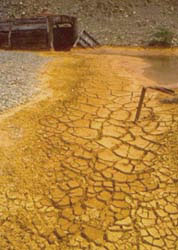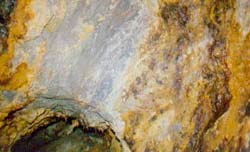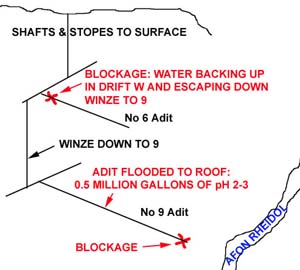JOHN S. MASON - PREVENTION
OF ENVIRONMENTAL DISASTER AT CWMRHEIDOL MINE, CENTRAL WALES, EARLY 1990s
Note: to return to the John's Conservation & Environmental page
click on EXIT
at the bottom of any of these pages.
PART 1 - The problem:
Cwmrheidol
mine accessed a lead-zinc bearing mineral lode but there was also a
great deal of the iron sulphide marcasite present. In time this decayed
into sulphuric acid which then attacked other minerals, resulting in a
mine drainage that was highly acidic and laden with an unpleasant
cocktail of polluting metals including zinc, cadmium and aluminium.

Here is an
image of the entrance to the No 9 Adit which was taken in the summer of
1992. Dried-up, cracked ochre (hydrated iron hydroxide) covers the
foreground. The timber lagging of the adit where it passes through
shaly scree can clearly be seen. The discharge flows into Afon Rheidol
via a settling tank put in by the C.E.G.B. in the 1970s. Filled with
limestone chips, this worked initially but is now less effective
because the reaction in time coats the limestone with insoluble gypsum. |

The mines
in this immediate area all worked mineralised fractures associated with
the Castell Lode, a major ENE-striking tensional fault system.
Immediately to the west of Cwmrheidol the lode could in the early 1990s
be seen at the neighbouring small Tynyfron mine, where over 1m of
shattered marcasite is exposed in pillars along the small stopes
(above). This gives an indication of the mineralisation cut by
Cwmrheidol, and why there is such a pollution problem there. |
|

This is a
simplified diagram of the mine. The oldest
part is up on the hilltop at Ystumtuen. Here, workings go back into the
1700s. Lewis Morris described the marcasite at Ystumtuen thus, in the
mid 18th Century:
"There is a vast
quantity of Marcasite
in this work, and it shoots into Chrystals of Copperas by the very heat
of ye Sun, but it is of very little value here being so far from the
Sea. The waste of this mine is worked over and over to profit Every
eight or ten years, the Marcasite being dissolved by the Rains and Heat
of the Sun Suffers the Ore to be disengaged" -
an early example there of heap-leaching!
The No 6 and No 9 levels at Cwmrheidol were driven more recently to
make dewatering the mine easier. No 6 was started in 1824 while No 9
was a later 19th Century venture. The main mine drainage exits from No
6 as a moderate stream. This tunnel drains a lot of the Ystumtuen area
and in heavy rain the water roars out. However, in the early 1990s
water was backed up due to a fall of ground, which allowed it to escape
down a winze into No 9 Adit.
|

In
1992, site
investigations were commissioned with a view to solving the pollution
problems. I was working with mining engineer, historian and archivist
Simon Hughes of Talybont back then. Examination of the No 9 adit
entrance identified an immediate cause for concern, with a shale dam
that had formed where the tunnel's wooden lagging had failed, allowing
the loose scree to run in. A local reported seeing water squirting out
upwards after prolonged rain.
What
if this dam
should have failed? The result would have been a sudden influx of over
500,000 gallons of ochreous acidic water into Afon Rheidol. This
actually happened in the late 1960s, when the blocked adit was
disturbed by a JCB and burst open. Thousands of fish were killed and
the sea off Aberystwyth Harbour turned orange! So, in this case what
did we do??
|
Next:
No 9 Adit - The solution to the problem
EXIT
|



